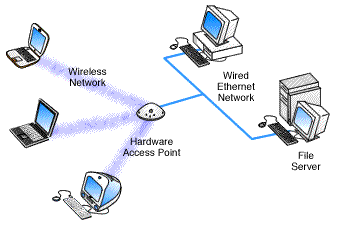Access Points Information
Access points are transmitters / receivers (transceivers) that connect to a network through an interface such as a b us or connector. They receive, store, and transmit data between the wireless local-area network (WLAN) and the wired structure. End-users access the network through wireless LAN adapters, which are also equipped with transceiver capabilities.
us or connector. They receive, store, and transmit data between the wireless local-area network (WLAN) and the wired structure. End-users access the network through wireless LAN adapters, which are also equipped with transceiver capabilities.
How Access Points Work
Access points are implemented as computer cards connected to the wired network through a bus, or as standalone modules connected to the wired network by mean of a suitable interface. They use radio techniques to transfer data, while avoiding as much interference as possible.
This diagram depicts a wired Ethernet network with a file server that uses a hardware access point to communicate with laptops and PCs in a wireless network.

Form Factor and Bus Interface Type
The Engineering360 SpecSearch database lets buyers select network access points by form factor and bus or interface type. The form factor may be either internal or external, and corresponds to a specific network communication type.
- Internal access points are computer cards that are attached to the computer through a slot. They are implemented, among others, as PCI, ISA, or PC cards (PCMCIA) in desktop computers, in notebook or palmtop computers, or integrated within hand-held computers.
- External access points are modules that connect to the system by means of a physical port.
Radio Techniques
When selecting products, buyers also need to specify a radio technique. The most commonly used one is spread spectrum. By using more bandwidth than the system needs, spread spectrum reduces the impact of localized  frequency interference.
frequency interference.
There are two main spread spectrum modalities: direct sequence and frequency hopping.
- Direct sequence is a technique where the signal is spread on a large band by multiplexing it with a code (signature) to minimize localized interference and noise. The system works over a large band. To spread the signal, each bit is modulated by a code.
- Frequency hopping uses a technique where the signal walks through a set of narrow channels in sequence. The transmitted frequency band is divided in certain number of channels, and periodically the system hop to a new channel, following a predetermined cyclic hopping pattern. The system avoids interference by never staying in the same channel a long period of time.
Other Important Specifications
When selecting between access points, buyers should also specify the rate at which the access point transfers data, the maximum output power, the number of channels, and sensitivity. Sensitivity is the measure of the weakest signal that may be reliably sensed by the receiver. It is measured in dBm, and the lower the value (higher in absolute value) the better is the receiver.
Resources
Connecting a Private Wireless Access Point to the Campus Network
Image credits:
eSecurity | n-Tron Corp. | National Instruments
- access point enclosure
- PoE wireless access point
- industrial access points
- blue point mt145
- 900MHz transmitter receiver
- MAC Address
- solar powered access points
- transport service access point
- 802.11n wireless access points
- cellular access points
- dual band wireless access points
- extender access point
- intrinsically safe WiFi access points
- intrinsically safe wireless access points
- mesh access points
- multiple antenna access points
- rugged access points
